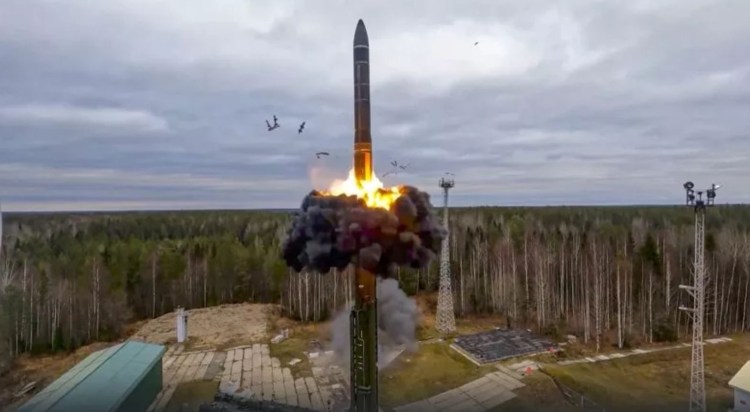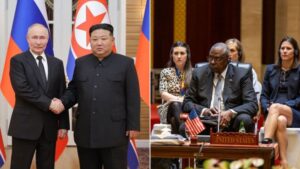In a significant escalation of the ongoing conflict, Russia has reportedly launched an intercontinental ballistic missile (ICBM) at Ukraine. If accurate, this would mark the first known use of such a weapon in active combat in the two-and-a-half-year-long war. The Ukrainian Air Force stated that the missile targeted the city of Dnipro, a central Ukrainian hub, and was fired from Russia’s Astrakhan region. This development follows Ukraine’s recent deployment of U.S.-supplied ATACMS and British Storm Shadow missiles against Russian targets, intensifying the military exchanges between the two nations in the final days of the Biden administration.
Capable of Carrying Nuclear Warheads
The missile in question is believed to be the RS-26 Rubezh, a solid-fueled ICBM equipped with multiple independently targetable reentry vehicles (MIRVs). Designed for rapid deployment and capable of carrying both conventional and nuclear warheads, the RS-26 has a range of approximately 5,800 kilometers. Its deployment in this context underscores a notable shift in Russia’s military strategy, introducing a weapon traditionally reserved for strategic deterrence into a regional conflict.
In a significant escalation of the ongoing conflict, Russia has reportedly launched an intercontinental ballistic missile (ICBM) at Ukraine. If accurate, this would mark the first known use of such a weapon in active combat in the two-and-a-half-year-long war. The Ukrainian Air Force stated that the missile targeted the city of Dnipro, a central Ukrainian hub, and was fired from Russia’s Astrakhan region. This development follows Ukraine’s recent deployment of U.S.-supplied ATACMS and British Storm Shadow missiles against Russian targets, intensifying the military exchanges between the two nations in the final days of the Biden administration.
Capable of Carrying Nuclear Warheads
The missile in question is believed to be the RS-26 Rubezh, a solid-fueled ICBM equipped with multiple independently targetable reentry vehicles (MIRVs). Designed for rapid deployment and capable of carrying both conventional and nuclear warheads, the RS-26 has a range of approximately 5,800 kilometers. Its deployment in this context underscores a notable shift in Russia’s military strategy, introducing a weapon traditionally reserved for strategic deterrence into a regional conflict.
The West Remains Skeptical
The attack on Dnipro resulted in significant damage to infrastructure and injuries to civilians. Ukrainian President Volodymyr Zelensky condemned the strike, highlighting the missile’s speed and altitude as indicative of its intercontinental capabilities. In response, NATO scrambled F-16 warplanes over Poland and heightened air defense alerts, reflecting the broader international concern over the escalation.
Western officials have expressed skepticism regarding the classification of the missile as an ICBM. Some suggest it may have been an intermediate-range ballistic missile, noting that the RS-26’s range places it at the lower threshold of ICBM classification. Regardless, the use of such a weapon in this conflict represents a significant escalation.
Western skepticism about Ukraine’s claim that Russia launched an intercontinental ballistic missile (ICBM) into Ukrainian territory is rooted in several key factors. ICBMs are primarily designed for long-range, strategic nuclear strikes, targeting locations thousands of kilometers away. Using such a weapon for a target within 700–800 kilometers, as reported in this case, would be highly inefficient.
These missiles are not only extremely costly but also less accurate for short-range targets, with the RS-26 Rubezh, for example, having a 200-meter Circular Error Probability (CEP). Additionally, ICBMs have limited effectiveness for conventional warfare, making their use in this scenario seem illogical.
Adding to the skepticism is the lack of confirmation from Russia and independent verification from Western intelligence agencies. Without concrete evidence supporting Ukraine’s claim, doubts remain about the exact nature of the missile used. Analysts speculate that if Russia did use a missile with ICBM-like characteristics, the act might have been more about sending a symbolic message to intimidate Ukraine and its Western allies rather than achieving a specific tactical goal. However, this kind of signaling could have been accomplished with less expensive and more practical means.
The combination of the weapon’s traditional purpose, the lack of clear evidence, and questions about the practicality of such a strike all contribute to Western doubts about Ukraine’s assertion. This situation underscores the complex nature of interpreting battlefield developments in a conflict fraught with propaganda and competing narratives.

Revisiting The Doomsday Clock: 90 Seconds To Midnight
Russia’s recent actions and threats have had a significant impact on the setting of the Doomsday Clock, which serves as a symbol of how close humanity is to global catastrophe. Since the Ukraine conflict began in February 2022, Russia has frequently issued nuclear threats, signaling its willingness to use its nuclear arsenal if it perceives an existential threat. This alarming rhetoric has heightened fears of nuclear escalation worldwide. As a result, in January 2023, the Bulletin of the Atomic Scientists moved the Doomsday Clock to 90 seconds to midnight—the closest it has ever been. This decision reflects the unprecedented dangers posed by the war in Ukraine and Russia’s nuclear posturing.
Adding to these concerns, Russia has expanded its military doctrine to include a broader range of scenarios in which it might use nuclear weapons. This includes potential responses to perceived threats from NATO or major military actions against its interests. The ambiguity in this approach increases the risk of miscalculation during conflicts, further elevating global nuclear tensions and influencing the Clock’s current position.

The breakdown of arms control agreements has also contributed to the dangerous global environment. Russia’s suspension of its participation in the New START treaty and withdrawal from the Comprehensive Nuclear Test Ban Treaty signal a step back in efforts to control nuclear weapons. This erosion of arms control frameworks undermines global stability and raises the stakes in the current geopolitical climate.
Despite these threats, the international community has largely united in condemning Russia’s nuclear rhetoric. World leaders have voiced strong opposition, emphasizing the need for cooperation to prevent the escalation of nuclear risks. While this collective pushback offers hope for mitigation, the overall situation remains precarious.
The war in Ukraine also highlights broader global challenges, including climate change, advancing technology, and other geopolitical tensions. These interconnected threats create a compounding effect, pushing humanity closer to catastrophe. The Bulletin’s decision to keep the Doomsday Clock at 90 seconds to midnight underscores the urgent need for global action to address these risks and ensure a safer future.
Summation
Today’s developments occur amid heightened tensions following Ukraine’s use of Western-supplied long-range missiles against Russian territory. Moscow has previously warned that such actions could prompt severe retaliation, including the potential use of nuclear weapons. The international community now faces the challenge of addressing this escalation while preventing further deterioration of the situation.
The deployment of an ICBM, or pseudo-ICBM, in an active conflict zone raises critical questions about the evolving nature of warfare and the thresholds for the use of strategic weapons. As the situation unfolds, the global community must navigate the delicate balance between supporting Ukraine’s sovereignty and preventing a broader escalation that could have far-reaching consequences.
The world waits and holds its collective breath, waiting for Donald Trump to retake office.



